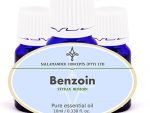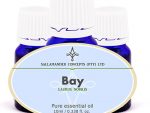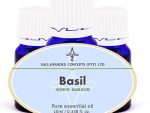Information on Pine essential oil
Pine essential oil is extracted from Scotch pine oil, which is extracted from Pinus sylvestris of the Pinaceae family and is also known as Scots and forest pine.
Although Pine Essential Oil can cause reactions (notably in cases of whooping cough and asthma), it is very useful to relieve mental, physical and sexual fatigue, while having a cleansing and clearing effect on a room.
Pine essential oil can be used in cystitis, hepatitis and prostate problems, as well as to improve circulation and to relieve rheumatism, gout, sciatica and arthritis.
Oil Properties
Pine Essential Oil has a fresh forest smell, is pale yellow in color and watery in viscosity.
This evergreen tree can grow up to 40 meters (130 feet) and has a flat crown and has a reddish-brown, deeply fissured bark, needle-like gray-green leaves that grow in pairs, orange-yellow flowers and pointed brown cones.
It is extensively cultivated for its wood, tar, pitch, turpentine and essential oil and was used by the Native Americans to prevent scurvy.
Mattresses where stuffed with the needles to repel lice and fleas and the ancient Egyptians used pine kernels in their cooking.
Extraction
Our product is extracted by steam distillation of the twigs and buds and yields about 0.1 -.05 %, although another type of oil can also be extracted by steam distilling the needles.
Chemical composition
Some of the main chemical properties of pine oil are α-Pinene, β-Pinene, δ-3-Carene, β-Pellandrene, δ-Cadinene, Camphene, α-Muurolene, β-Bisabolene, (+)-Limonene
Precautions
Although pine and pine needle oil is considered non-toxic and non-irritant if used topically at the correct dilution rate, the essential oil does oxidise rather easily. Oxidised essential oils irritate the skin easily.
We suggest that you include the addition of an antioxidant when making a mixture including this oil – such as vitamin E oil – this will prolong the life of your mixture
As with most essential oils, this essential oil should be kept in a dark and cool place and should be stored in an airtight glass bottle (Preferably in the fridge at a temperature of around 4° Celsius / 39° Fahrenheit).
Note: Cleaning products containing Pinene or pine essential oil may be toxic to cats – if the cat walks over a surface that has just been cleaned, the substance may enter the cat’s blood stream through the paws and cause liver problems that may steadily get worse with repeated exposure (depending on how high the Pinene concentration in the cleaning mixture is).
Please read our page with heading: Safety with Essential Oils before using this oil.
We recommend the following book as an excellent resource regarding safety:
Essential Oil Safety: A Guide for Health Care Professionals by Robert Tisserand & Rodney Young (#ad)
Therapeutic properties
The therapeutic properties of Pine Essential Oil are antimicrobial, antineuralgic, antirheumatic, antiseptic, antiviral, bactericidal, balsamic, cholagogue, deodorant, diuretic, expectorant, hypertensive, insecticidal, restorative, rubefacient, adrenal cortex stimulant as well as stimulant to the circulation and nervous system.
For our glossary and explanation of these therapeutic terms, please click here
Uses
Pine Essential Oil is most useful to relieve mental, physical and sexual fatigue, while having a cleansing and invigorating effect on an area and is great for vapor therapy in a sick room as it promotes healing. It can be used for cuts and sores, scabies and lice and for excessive perspiration, while its warming properties help with rheumatism, arthritis, gout, muscular aches and pains and it can stimulate circulation. Furthermore it can help in cases of bronchitis, asthma, catarrh, coughs, laryngitis, colds and flu.
It eases breathlessness and sinusitis, but should be avoided in cases of bronchial asthma and whooping cough.
As a general kidney cleanser, it is effective with cystitis, prostate problems and urinary infections and can also help with nervous exhaustion, neuralgia and mental fatigue.
Burners and vaporizers
In vapor therapy it can be used for colds, coughs, smokers cough, drowsiness, hangover and sinusitis.
Blended Massage Oil or in the Bath
In a blended massage oil or diluted in the bath, it can be used for cellulite, colds, coughs, hangover, infections, rheumatism and sinusitis.
Care should however be taken if you are prone to allergic reactions, and this oil may also irritate the mucus membranes.
Suggested Dilution Rates
On the skin
Adult:
Face: 0.5% to 1.5%
Body: 0.5% to 3%
Bath: 0.5% to 4%
3 to 24 months:
Face: 0.25% to 0.5%
Body: 0.25% to 0.5%
Bath: Maximum of 0.5%
2 to 6 years:
Face: 0.5% to 1.5%
Body: 0.5% to 2%
Bath: 0.5% to 2 %
6 to 15 years
Face: 0.5% to 1.5%
Body: 0.5% to 3%
Bath: 0.5% to 3%
Pregnancy
Face: 0.5% to 1.5%
Body: 0.5% to 2%
Bath: 0.5% to 2%
- When in doubt consult your doctor / medical professional before use.
- Most professionals and/or Aromatherapists will always err on the side of safety when giving advice regarding the use of essential oils and oleo resins during pregnancy.
- Quite a number of Aromatherapists advise that you should avoid all essential oils completely while pregnant, specifically during the first trimester. This is a very safe approach but may not be necessary at all.
Diffusers and Vaporisers
4 to 8 drops
General:
- When using for the first time – Always use the lowest dilution rate and build up slowly to the maximum. Stop using all essential oils on the skin if irritation or allergy occurs.
- Any advice or instruction received from a medical professional ALWAYS supersedes recommendations or advice found on this website. When in doubt consult your doctor / medical professional.
Summary
Pine Essential Oil can be useful in the treatment of the respiratory tract, for muscular aches and pains, and as a urinary cleanser.
Blends
Although most essential oils blend well with one another pine oil blends particularly well with Cedarwood, Eucalyptus, Lavender, Niaouli, Rosemary and Sage.





